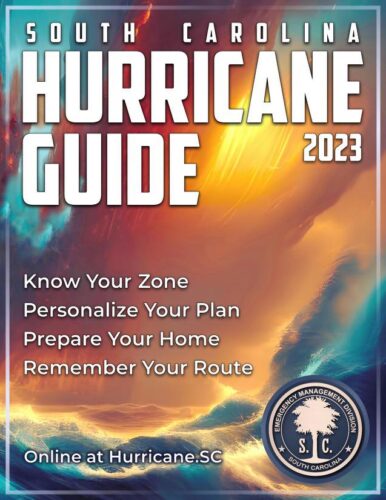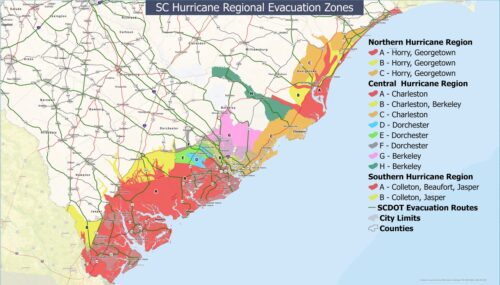
Hurricane Season runs from June through November each year. The peak months for hurricane activity are August and September. The greatest threat to life and property associated with a hurricane and tropical storm is storm surge. Other effects include high winds, tornadoes, and inland flooding associated with heavy rainfall that usually accompanies these storms. You can take steps to minimize the loss of life or property during a hurricane.
SCEMD Hurricane Guide 2023
The South Carolina Hurricane Guide is updated annually by SCEMD in collaboration with local and state partners of the S.C. Emergency Response Team. All information contained in the Guide is valid at the time of publishing each year, but is subject to change depending on actual storm conditions.
Guía de Preparación de Huracanes 2023
Build Your Plan
- Have a hurricane plan and ensure everyone in the household knows the plan.
- Know your evacuation route.
- Have an emergency supplies kit prepared, to include at least: three days’ drinking water (two gallons per person per day); non-perishable food; flashlight with extra batteries; portable battery-operated radio; first-aid kit; non-electric can opener; essential medicines; cash and credit cards.
- Make a plan for family members with Specific Needs.
- Make arrangements for pets. Pets are not allowed in official shelters.
- Protect your home by covering windows with permanent shutters, plywood panels or other shielding materials. Bring in lawn furniture and other loose objects, such as garbage cans, that may become a hazard during high winds.
- Install straps or additional clips to securely fasten your roof to the frame structure. This will reduce roof damage.
- Be sure trees and shrubs around your home are well-trimmed.
- Clear loose and clogged rain gutters and downspouts.
- Determine how and where to secure your boat.
- Fuel up and service family vehicles.
Know your zone
South Carolina residents and visitors can learn about hurricane evacuation zones and their vulnerability to storm surge on South Carolina’s coast with our Know Your Zone interactive map. You can download the SCEMD app or visit their website to look at your zone.
It’s very simple to use. Simply enter your address or the address of your desired location. You can also use the “Use Your Location” button to quickly move to your location. Users can zoom in and out of the map as well as move around to review any other areas of interest.
Stay connected
Listen for emergency information and alerts.
- National Hurricane Center
- NOAA Radio
- SCETV Weather
- SCEMD app or website
- Local Media
- Social Media
- Follow us on Twitter, Facebook, Nextdoor, Neighbors & Instagram: @NCFDSC
Shelters
Emergency shelters may be opened with the approach of a hurricane to South Carolina. Shelters should generally be used as a place of last resort, as individuals and families are encouraged to have emergency plans in place. These plans should include relatives or friends with whom you can stay or locations to which you will travel. In the event that you must use a shelter, there are two types: American Red Cross and Special Medical Needs Shelters (SMNS). Only individuals with special medical needs will be admitted to SMNS.
If you relocate to a shelter, be sure to bring blankets and pillows, food for the three day, and any necessary medications and sanitary supplies. It is highly recommended that you bring your Emergency Supplies Kit.
In the event of a major disaster, SCEMD and Charleston County, Dorchester County and Berkeley County will update shelter opening via their websites, apps and local media.
